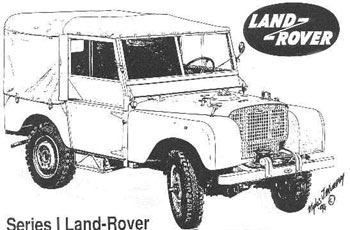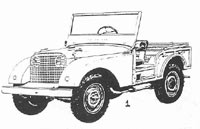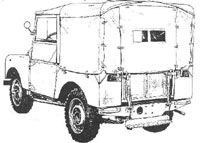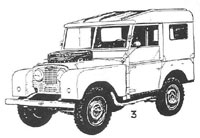Know your Rovers: The
First Land Rovers, 1947 - 1953
by Miles J. Murphy

Rovers
chief engineer Maurice Wilks came up with the idea for a "Land
Rover" while
on holiday in Wales during the Easter Break, 1947.
Earlier
in the year, Wilks purchased a surplus U.S. built Willys Jeep
for his own use. Not only would this vehicle serve as the inspiration
for the "Land" Rover, but it would provide many of its components
for the very first Land Rover (see drawing #1)). Among the
items used were: chassis, the complete drivetrain, up to and
including the Jeep transfer box. The Jeep steering assembly,
up to and including the steering box. The prototype Land Rover
had a centre steering wheel (neither LHD or RHD) linkage to
the Jeep steering box via chain and sprockets. From photo evidence
it would appear that many other items were from the Jeep were
incorporated into the prototype. Quite a number of these bits
'n pieces have remained standard items on civil and military
Land Rovers to this day.
Simply put, without getting too bogged
down in the history of the times, and the Rover Car Company's
reasons for getting into the 4x4 business - the Land Rover
was intended as a stop-gap product to keep the company "in
business" in the lean years following World War Two. At that
time all Rover had to offer was it pre-War luxury car designs
that no one wanted or could afford. The also had a prototype "compact" car
in the works but the market for that vehicle did not seem to
be materializing.
The post World War 2 British economy was
in shambles. Strict rationing was in the order of the day and
there was an enormous foreign debt to take care of. The Ministry
of Supply ordered (that's putting it mildly) all manufacturers
to export up to 75% of their products. This draconian policy
was necessary to bring in the vitally needed hard currency
to help service the debt. Truck and tractor manufacturers were
doing brisk trade overseas, but there was little or no demand
in the rapidly changing post-War world for what Rover had to
offer. Prior to the Second World War the Rover Company did
very well for itself providing luxury cars for the upper classes.
So smug were they that they never built left hand drive vehicles,
there being more than enough business at home and in the right
hand drive colonies.
Another post hostilities problem Rover
faced was the rationing of raw materials, least of which was
a severe shortage of steel. The Ministry of Supply controlled
the flow of these vitally needed raw materials, and companies
were allocated stocks based on their export performance. Export
was something the Rover Company had little experience with.
With the future of the company at stake, the decision was made
to rush head long into getting a four by four into production.
All the usual design and development procedures were dispensed
with. There was neither the time or the money to develop engines
and gearboxes, or the tools, jigs, molds, presses and dies
that are a necessary part of getting a production line going.
Everything needed for the new vehicle would have to come from
available stocks and used "as is" or modified. Major components
such as the chassis and the bulkhead would have to be made
by hand. Once they got the "show on the road" - if ever - then
and only then would money be invested in the necessary tooling.
No sooner had Wilks returned from his holidays that work began.
The above mentioned hybrid Jeep/Land Rover prototype was driving
about in September 1947. The engine and gearbox came from the
Rover car line. The new body on the Jeep chassis was a type
of aluminum used in aircraft manufacture as was the paint
the vehicle was finished with. Both of these items come from
stocks held by Rover from its wartime aircraft manufacturing
efforts. 
While the prototype was being built more Jeeps were acquired
for test and evaluation purposes. However, these vehicles were "purchased" by Rover
staff and "not" by the company itself. Wilk's Jeep is believed to have been
the donor vehicle for the Land Rover prototype. The prototype met its demise
early in 1948. Why the first Land Rover was dismantled is a mystery. If it
had something in common with pre-production and production models a fellow
could understand the need to take it apart to see what it was - or was not
- falling apart. It is possible Rover was destroying the evidence. I'm sure
that the Willys Overland Company of the USA would have something to say about
their product being used to help another company develop a vehicle that would
soon overtake them in the world market. Lessons learned building the prototype
helped with design and development of the pre-production vehicles. Work on
the pre-production Land Rovers commenced in late 1947. In all, 48 pre-production
vehicles were built, the first rolling "off the line" on or about March 11th
1948. In some way or other most if not all - were different from each other.
All had a galvanized chassis, some of the first had an integral bumper while
later ones had the bolt on type. All were skinned in Birmabright, with the
first 40 vehicles painted a light green (sage green). The final 8 were painted
in a darker shade of green (bordering on olive green).
The first time the public
got wind of the new Land Rover was an article in "The Times" newspaper on April
20th, 1948. The first public appearance of the Land Rover was held ten days
later at the Amsterdam Motor Show, held in the Netherlands between April 30th
and May 9th, 1948.
The last of the 48 pre-production land Rovers were completed
around the end of July, beginning of August 19948. By that time production
models were already rolling off an adjacent assembly line. By the end of 1948,
the pre-production batch were spread all over the place undergoing trials and
the like. Some were sold to early customers whose orders could not be filled
by production models. Quite a number of these pre-production 48 survive to
this day (what else is new, eh), including the first R.01.
 The
first production models had permanent 4wd. The galvanized chassis of the pre-production
batch had given way to silver paint and duralumin replaced the birmabright.
In time, the silver painted chassis would give way to green and after a May
1949 Ministry of Defense order for 1878 vehicles, Land Rovers were finished
in bronze green, regardless of whether they were destined for military use
of not.
The
first production models had permanent 4wd. The galvanized chassis of the pre-production
batch had given way to silver paint and duralumin replaced the birmabright.
In time, the silver painted chassis would give way to green and after a May
1949 Ministry of Defense order for 1878 vehicles, Land Rovers were finished
in bronze green, regardless of whether they were destined for military use
of not.
The production models were constantly being refined. With the phenomenal
success of the 80" Land Rover, the Rover company could now invest in machinery
to do the work that had been done by hand. Constant feedback from customers
kept the Land Rover in a constant state of change. Every month or two, there
would be something new to take note of.
Trying to identify a specific model
is no easy task, serial number or not. There always seems to be an interim
model between two distinct versions. Nothing was wasted. While stock of a particular
part lasted, it would continue to appear on a "new" model, until there was
no more. A number of "interim" Land Rovers were shipped to North America sometime
in the early 1950's (see drawing #3). 
Six are known to exist, three are on the road, and two are under restoration.
The serial numbers date them as 1950, but they have features dating from mid
1949 to at least mid 1951. One unique feature to all is the relocation of the
bulkhead sidelights to a non-standard position on the front wings. The fairings
that housed the sidelights in their original location are still there. The
most recent of these "N.A. Spec" 80" Land Rovers was discovered in superb complete,
original, rust free condition in a Tuscan Arizona junk yard. Its owner us restoring
it to original condition - wing mounted lights and all.
The two pages of drawings
serve to illustrate the distinct features of the prototype, pre-production
and production models. Obviously there is a lot more to it, but I'll leave
that to someone else to explain. Take note: All illustrations are freehand.
if the small drawings look a bit funny, it is due to photocopier distortion
when the originals are reduced several times.
Drawings: Main
subjects, front and rear views of a typical pre-production vehicle. Production
vehicles from July 1948 to June 1950 looked much the same. Strap and buckles
were used to secure the canvas tilt and the support hoops were flat on top.
Final
note: During their day, what we call series ones were simply
Land Rovers. when the 86" and 107" came along they became Land Rover 80", 86" or
107". The same applies to the 88" and 109" versions. With the
advent of the Series II Land Rovers in 1958, the term Series
One came into being. Since then, all vehicles built prior to
1958 are referred to as Series Ones.
Nothing
printed here is Gospel, but what do you expect for free, eh!
Reprinted
from the OVLR Newsletter, January, 1995



















